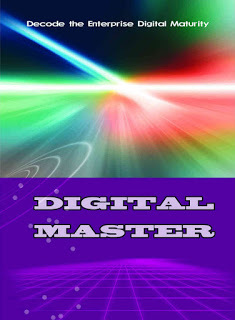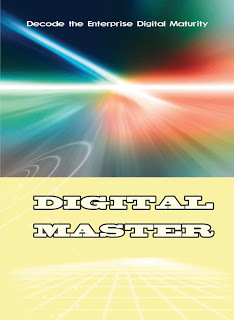Pearl Zhu's Blog, page 1400
October 2, 2015
Digital Master Chapter VII Introduction: Digital Intelligence
Digital means flow: data flow, information flow, knowledge flow, and mind flow.
 A digital shift is a mind-set shift, which also comes with information shift, a shift that organizations will take advantage of information to gain knowledge and insight, a shift to drive culture and transformation toward a more intelligent enterprise, a shift from playing smart tools to being an intelligent business, it’s about building such cohesive, agile and intellectual capabilities to adapt to the continuous change and unpredictable disruptions. The abundance of data and information brings both significant opportunities and enormous risks in business today, as organizations can harness the power of data to provide the business with a more fact-based vision of where to aim and how to get there, through identifying the right data, validating it and communicating it to right people at the right time. Along the journey, many organizations intend to decode digital intelligence and move up the maturity curve from knowing “what happened” to “why did it happen” (with root cause) to what will happen (capture the trends).
A digital shift is a mind-set shift, which also comes with information shift, a shift that organizations will take advantage of information to gain knowledge and insight, a shift to drive culture and transformation toward a more intelligent enterprise, a shift from playing smart tools to being an intelligent business, it’s about building such cohesive, agile and intellectual capabilities to adapt to the continuous change and unpredictable disruptions. The abundance of data and information brings both significant opportunities and enormous risks in business today, as organizations can harness the power of data to provide the business with a more fact-based vision of where to aim and how to get there, through identifying the right data, validating it and communicating it to right people at the right time. Along the journey, many organizations intend to decode digital intelligence and move up the maturity curve from knowing “what happened” to “why did it happen” (with root cause) to what will happen (capture the trends).
 The abundance of data and information brings both significant opportunities and enormous risks in business today, as organizations can harness the power of data to provide the business with a more fact-based vision of where to aim and how to get there, through identifying the right data, validating it and communicating it to right people at the right time. Along the journey, many organizations intend to decode digital intelligence and move up the maturity curve from knowing “what happened” to “why did it happen” (with root cause) to what will happen (capture the trends).1. We are moving slowly into an era where Big Data is the starting point - not the end.
The abundance of data and information brings both significant opportunities and enormous risks in business today, as organizations can harness the power of data to provide the business with a more fact-based vision of where to aim and how to get there, through identifying the right data, validating it and communicating it to right people at the right time. Along the journey, many organizations intend to decode digital intelligence and move up the maturity curve from knowing “what happened” to “why did it happen” (with root cause) to what will happen (capture the trends).1. We are moving slowly into an era where Big Data is the starting point - not the end.
2. Digital means flow: data flow, information flow, knowledge flow, and mind flow.
3. Digital IQ is a measure of how well companies understand the value of technology and weave it into the fabric of their organization.
4. Digital EQ has three dimensions: Emotional Intelligence, Execution Excellence and Employee Engagement.
5. Every risk has opportunities in it; and every opportunity has risks in it.
6. Empathy is the core foundation in customer thinking and very purpose customer intelligence shall capture.
7. Intelligence is not only the ability to reason; it is also the ability to find relevant material in memory and to deploy attention when needed. -Daniel Kahneman “Think Fast and Slow"
8. ”Not everything that can be counted counts and not everything that counts can be counted” -Albert Einstein. Digital Master Featured URLs:Digital Master Author Home PageDigital Master on Future of CIO BlogDigital Master at FlipboardDigital Master at TwitterDigital Master on LinkedinGoodreads Author’s Home PageDigital Master Introduction, Fun Quiz on SlideshareDigital Master Introduction on Youtube
Digital Master Online Order Links:Digital Master on AmazonDigital Master on B&NDigital Master on Apple iTunesDigital Master on LuLuDigital Master on Google BooksDigital Master on KOBODigital Master on FeedbooksDigital Master on BOL
Follow us at: @Pearl_Zhu
 A digital shift is a mind-set shift, which also comes with information shift, a shift that organizations will take advantage of information to gain knowledge and insight, a shift to drive culture and transformation toward a more intelligent enterprise, a shift from playing smart tools to being an intelligent business, it’s about building such cohesive, agile and intellectual capabilities to adapt to the continuous change and unpredictable disruptions. The abundance of data and information brings both significant opportunities and enormous risks in business today, as organizations can harness the power of data to provide the business with a more fact-based vision of where to aim and how to get there, through identifying the right data, validating it and communicating it to right people at the right time. Along the journey, many organizations intend to decode digital intelligence and move up the maturity curve from knowing “what happened” to “why did it happen” (with root cause) to what will happen (capture the trends).
A digital shift is a mind-set shift, which also comes with information shift, a shift that organizations will take advantage of information to gain knowledge and insight, a shift to drive culture and transformation toward a more intelligent enterprise, a shift from playing smart tools to being an intelligent business, it’s about building such cohesive, agile and intellectual capabilities to adapt to the continuous change and unpredictable disruptions. The abundance of data and information brings both significant opportunities and enormous risks in business today, as organizations can harness the power of data to provide the business with a more fact-based vision of where to aim and how to get there, through identifying the right data, validating it and communicating it to right people at the right time. Along the journey, many organizations intend to decode digital intelligence and move up the maturity curve from knowing “what happened” to “why did it happen” (with root cause) to what will happen (capture the trends).
 The abundance of data and information brings both significant opportunities and enormous risks in business today, as organizations can harness the power of data to provide the business with a more fact-based vision of where to aim and how to get there, through identifying the right data, validating it and communicating it to right people at the right time. Along the journey, many organizations intend to decode digital intelligence and move up the maturity curve from knowing “what happened” to “why did it happen” (with root cause) to what will happen (capture the trends).1. We are moving slowly into an era where Big Data is the starting point - not the end.
The abundance of data and information brings both significant opportunities and enormous risks in business today, as organizations can harness the power of data to provide the business with a more fact-based vision of where to aim and how to get there, through identifying the right data, validating it and communicating it to right people at the right time. Along the journey, many organizations intend to decode digital intelligence and move up the maturity curve from knowing “what happened” to “why did it happen” (with root cause) to what will happen (capture the trends).1. We are moving slowly into an era where Big Data is the starting point - not the end.
2. Digital means flow: data flow, information flow, knowledge flow, and mind flow.
3. Digital IQ is a measure of how well companies understand the value of technology and weave it into the fabric of their organization.
4. Digital EQ has three dimensions: Emotional Intelligence, Execution Excellence and Employee Engagement.
5. Every risk has opportunities in it; and every opportunity has risks in it.
6. Empathy is the core foundation in customer thinking and very purpose customer intelligence shall capture.
7. Intelligence is not only the ability to reason; it is also the ability to find relevant material in memory and to deploy attention when needed. -Daniel Kahneman “Think Fast and Slow"
8. ”Not everything that can be counted counts and not everything that counts can be counted” -Albert Einstein. Digital Master Featured URLs:Digital Master Author Home PageDigital Master on Future of CIO BlogDigital Master at FlipboardDigital Master at TwitterDigital Master on LinkedinGoodreads Author’s Home PageDigital Master Introduction, Fun Quiz on SlideshareDigital Master Introduction on Youtube
Digital Master Online Order Links:Digital Master on AmazonDigital Master on B&NDigital Master on Apple iTunesDigital Master on LuLuDigital Master on Google BooksDigital Master on KOBODigital Master on FeedbooksDigital Master on BOL
Follow us at: @Pearl_Zhu
Published on October 02, 2015 19:54
Digital Master Chapter VI Introduction: Digital Innovation
Innovation is more often composed with the full spectrum of light.
 Generally speaking, innovation is how to transform the novel ideas into products and services to achieve its business value. Innovation has more enriched context than ever, and there are many forms of innovation - technology, application, product, design, process, business model, communication, management, culture and customer experience - just to name a few. Each has its own unique pathways.
Generally speaking, innovation is how to transform the novel ideas into products and services to achieve its business value. Innovation has more enriched context than ever, and there are many forms of innovation - technology, application, product, design, process, business model, communication, management, culture and customer experience - just to name a few. Each has its own unique pathways.
Businesses simply can’t depend on happenstance, and the most successful ones understand that clearly, the better way is to crack innovation serendipity code, and manage their innovation portfolio more systematically. You may read this chapter to discover the innovation life cycle management step by step. Due to the “creative” nature of innovation, Businesses just have to continue to experiment the next practices, so read this chapter for getting these innovation practices in details as well.
 1. Innovation is more often composed with the full spectrum of light. Innovation is what leads to differentiation.
1. Innovation is more often composed with the full spectrum of light. Innovation is what leads to differentiation.
2. There are many ways to differentiate and therefore there are many way to differentiate and therefore there are many ways to build innovation into a corporate strategy.
3. Innovation has to become the philosophy, and part of DNA in an organization.
4. The spark of innovation needs a framework to shine through and focus upon.
5. Innovation is the only bridge to mind digital gaps.
6. Digital hyper-connectivity can foster innovation through collaboration.The hybrid nature of innovation is a combination of something old with something new, with the mixed portfolio of incremental innovations and radical innovations.
7. Innovation agility is a critical business capability to manage the innovation life cycle with speed.
8. Management innovation has both hard elements such as process and metrics; as well as soft elements such as communication and culture.
9. Innovation is the art at the eyes of artist; the science at the mind of scientist; and the bridge between the art and science.
Digital Master Featured URLs:Digital Master Author Home PageDigital Master on Future of CIO BlogDigital Master at FlipboardDigital Master at TwitterDigital Master on LinkedinGoodreads Author’s Home PageDigital Master Introduction, Fun Quiz on SlideshareDigital Master Introduction on Youtube
Digital Master Online Order Links:Digital Master on AmazonDigital Master on B&NDigital Master on Apple iTunesDigital Master on LuLuDigital Master on Google BookDigital Master on KOBODigital Master on FeedbooksDigital Master on BOL
Follow us at: @Pearl_Zhu
 Generally speaking, innovation is how to transform the novel ideas into products and services to achieve its business value. Innovation has more enriched context than ever, and there are many forms of innovation - technology, application, product, design, process, business model, communication, management, culture and customer experience - just to name a few. Each has its own unique pathways.
Generally speaking, innovation is how to transform the novel ideas into products and services to achieve its business value. Innovation has more enriched context than ever, and there are many forms of innovation - technology, application, product, design, process, business model, communication, management, culture and customer experience - just to name a few. Each has its own unique pathways.
Businesses simply can’t depend on happenstance, and the most successful ones understand that clearly, the better way is to crack innovation serendipity code, and manage their innovation portfolio more systematically. You may read this chapter to discover the innovation life cycle management step by step. Due to the “creative” nature of innovation, Businesses just have to continue to experiment the next practices, so read this chapter for getting these innovation practices in details as well.
 1. Innovation is more often composed with the full spectrum of light. Innovation is what leads to differentiation.
1. Innovation is more often composed with the full spectrum of light. Innovation is what leads to differentiation.
2. There are many ways to differentiate and therefore there are many way to differentiate and therefore there are many ways to build innovation into a corporate strategy.
3. Innovation has to become the philosophy, and part of DNA in an organization.
4. The spark of innovation needs a framework to shine through and focus upon.
5. Innovation is the only bridge to mind digital gaps.
6. Digital hyper-connectivity can foster innovation through collaboration.The hybrid nature of innovation is a combination of something old with something new, with the mixed portfolio of incremental innovations and radical innovations.
7. Innovation agility is a critical business capability to manage the innovation life cycle with speed.
8. Management innovation has both hard elements such as process and metrics; as well as soft elements such as communication and culture.
9. Innovation is the art at the eyes of artist; the science at the mind of scientist; and the bridge between the art and science.
Digital Master Featured URLs:Digital Master Author Home PageDigital Master on Future of CIO BlogDigital Master at FlipboardDigital Master at TwitterDigital Master on LinkedinGoodreads Author’s Home PageDigital Master Introduction, Fun Quiz on SlideshareDigital Master Introduction on Youtube
Digital Master Online Order Links:Digital Master on AmazonDigital Master on B&NDigital Master on Apple iTunesDigital Master on LuLuDigital Master on Google BookDigital Master on KOBODigital Master on FeedbooksDigital Master on BOL
Follow us at: @Pearl_Zhu
Published on October 02, 2015 19:36
Digital Master Chapter V Introduction: Digital Capability
Digital capability is synthetic in nature, and focusing on long-term competency.
 A business capability is the set of abilities needed by an organization in order to deliver value. It’s the ability of an organization to do things effectively to achieve desired outcomes and measurable benefits and fulfill business demand. In today’s business dynamic, digital capabilities are a fundamental building block in digital transformations with which companies can transform customer experiences, operational processes, and business models, to reach high-level business agility and maturity.
A business capability is the set of abilities needed by an organization in order to deliver value. It’s the ability of an organization to do things effectively to achieve desired outcomes and measurable benefits and fulfill business demand. In today’s business dynamic, digital capabilities are a fundamental building block in digital transformations with which companies can transform customer experiences, operational processes, and business models, to reach high-level business agility and maturity.
The often described business capabilities include such as robustness, speed, comprehensiveness, responsiveness, agility, improvement, sensitivity, optimization, resilience, etc. Read this chapter to figure out the characteristics of digital capabilities:
 1. Digital capability is synthetic in nature, embedding agility in processes and focusing on long-term competency.
1. Digital capability is synthetic in nature, embedding agility in processes and focusing on long-term competency.
2. Digital capabilities cut across all functional pillars. They are fundamental building blocks for business transformation.
3. Strategy execution takes both capabilities and disciplines. Innovation is about reducing the unnecessary complexity.
4. Complexity is not just a phenomenon, it can be perceived as a property of a system.
5. The business capability is at a higher level than business process, and it is in the conceptual layer.
6. The core business capabilities are integrated set of capabilities contribute directly to the competitive advantage of business.
7. Business capability mapping is about measures of “importance,” “maturity,” and “performance” attached to each capability.
Digital Master Featured URLs:Digital Master Author Home PageDigital Master on Future of CIO BlogDigital Master at FlipboardDigital Master at TwitterDigital Master on LinkedinGoodreads Author’s Home PageDigital Master Introduction, Fun Quiz on SlideshareDigital Master Introduction on YoutubeDigital Master Online Order Links:
Digital Master on AmazonDigital Master on B&NDigital Master on Apple iTunesDigital Master on LuLuDigital Master on Google BooksDigital Master on KOBODigital Master on FeedbooksDigital Master on BOL
Follow us at: @Pearl_Zhu
 A business capability is the set of abilities needed by an organization in order to deliver value. It’s the ability of an organization to do things effectively to achieve desired outcomes and measurable benefits and fulfill business demand. In today’s business dynamic, digital capabilities are a fundamental building block in digital transformations with which companies can transform customer experiences, operational processes, and business models, to reach high-level business agility and maturity.
A business capability is the set of abilities needed by an organization in order to deliver value. It’s the ability of an organization to do things effectively to achieve desired outcomes and measurable benefits and fulfill business demand. In today’s business dynamic, digital capabilities are a fundamental building block in digital transformations with which companies can transform customer experiences, operational processes, and business models, to reach high-level business agility and maturity.The often described business capabilities include such as robustness, speed, comprehensiveness, responsiveness, agility, improvement, sensitivity, optimization, resilience, etc. Read this chapter to figure out the characteristics of digital capabilities:
 1. Digital capability is synthetic in nature, embedding agility in processes and focusing on long-term competency.
1. Digital capability is synthetic in nature, embedding agility in processes and focusing on long-term competency.
2. Digital capabilities cut across all functional pillars. They are fundamental building blocks for business transformation.
3. Strategy execution takes both capabilities and disciplines. Innovation is about reducing the unnecessary complexity.
4. Complexity is not just a phenomenon, it can be perceived as a property of a system.
5. The business capability is at a higher level than business process, and it is in the conceptual layer.
6. The core business capabilities are integrated set of capabilities contribute directly to the competitive advantage of business.
7. Business capability mapping is about measures of “importance,” “maturity,” and “performance” attached to each capability.
Digital Master Featured URLs:Digital Master Author Home PageDigital Master on Future of CIO BlogDigital Master at FlipboardDigital Master at TwitterDigital Master on LinkedinGoodreads Author’s Home PageDigital Master Introduction, Fun Quiz on SlideshareDigital Master Introduction on YoutubeDigital Master Online Order Links:
Digital Master on AmazonDigital Master on B&NDigital Master on Apple iTunesDigital Master on LuLuDigital Master on Google BooksDigital Master on KOBODigital Master on FeedbooksDigital Master on BOL
Follow us at: @Pearl_Zhu
Published on October 02, 2015 19:22
Digital Master Chapter IV Introduction: Digital Culture
The strategy is about living a holistic, integrative and transdisciplinary perspective.
 Culture is the collective mind-set: attitude, behavior or approach to work adopted by or embedded among a group of people in the conduct of business. Every organization has a culture, whether defined or not. Actual culture is a function of leadership, starting at the top. Culture is like the “glue” that holds and binds an organization together. It is the most invisible, but powerful, fabric weaved in the organizations and surrounding the society as well.
Culture is the collective mind-set: attitude, behavior or approach to work adopted by or embedded among a group of people in the conduct of business. Every organization has a culture, whether defined or not. Actual culture is a function of leadership, starting at the top. Culture is like the “glue” that holds and binds an organization together. It is the most invisible, but powerful, fabric weaved in the organizations and surrounding the society as well.
There are many culture metaphors; culture is like soil, the glue, the fabric or the mixing colors of paint. Culture is like the “glue” that holds and binds an organization together. It is the most invisible, but powerful, fabric weaved in the organizations and surrounding the society as well. Culture is like water; it can keep the enterprise ship afloat and push it toward the right direction, or it can drag down the ship, even sink it. Culture could also be analogized to the “spirit” of the organization – much like the “soul or spirit” of a human being and the spirit of the organization comes from the top. Culture is like air, we all have to share together, keep it fresh.
The Culture Assessment Questionnaires:1. Why is culture so critical in business success?2. What are the symptoms of toxic culture?3. What kind of culture do you have and is it in alignment with what you are trying to achieve?4. If not, identify the culture gaps between what you have and what you want, and work toward that end. 5. How do you effectively change and in what time frame do you make the transition? And can you?
Digital Master Featured URLs:Digital Master Author Home PageDigital Master on Future of CIO BlogDigital Master at FlipboardDigital Master at TwitterDigital Master on LinkedinGoodreads Author’s Home PageDigital Master Introduction, Fun Quiz on SlideshareDigital Master Introduction on Youtube
Digital Master Online Order Links:Digital Master on AmazonDigital Master on B&NDigital Master on Apple iTunesDigital Master on LuLuDigital Master on Google BooksDigital Master on KOBODigital Master on FeedbooksDigital Master on BOL
Follow us at: @Pearl_Zhu
 Culture is the collective mind-set: attitude, behavior or approach to work adopted by or embedded among a group of people in the conduct of business. Every organization has a culture, whether defined or not. Actual culture is a function of leadership, starting at the top. Culture is like the “glue” that holds and binds an organization together. It is the most invisible, but powerful, fabric weaved in the organizations and surrounding the society as well.
Culture is the collective mind-set: attitude, behavior or approach to work adopted by or embedded among a group of people in the conduct of business. Every organization has a culture, whether defined or not. Actual culture is a function of leadership, starting at the top. Culture is like the “glue” that holds and binds an organization together. It is the most invisible, but powerful, fabric weaved in the organizations and surrounding the society as well.There are many culture metaphors; culture is like soil, the glue, the fabric or the mixing colors of paint. Culture is like the “glue” that holds and binds an organization together. It is the most invisible, but powerful, fabric weaved in the organizations and surrounding the society as well. Culture is like water; it can keep the enterprise ship afloat and push it toward the right direction, or it can drag down the ship, even sink it. Culture could also be analogized to the “spirit” of the organization – much like the “soul or spirit” of a human being and the spirit of the organization comes from the top. Culture is like air, we all have to share together, keep it fresh.
The Culture Assessment Questionnaires:1. Why is culture so critical in business success?2. What are the symptoms of toxic culture?3. What kind of culture do you have and is it in alignment with what you are trying to achieve?4. If not, identify the culture gaps between what you have and what you want, and work toward that end. 5. How do you effectively change and in what time frame do you make the transition? And can you?
Digital Master Featured URLs:Digital Master Author Home PageDigital Master on Future of CIO BlogDigital Master at FlipboardDigital Master at TwitterDigital Master on LinkedinGoodreads Author’s Home PageDigital Master Introduction, Fun Quiz on SlideshareDigital Master Introduction on Youtube
Digital Master Online Order Links:Digital Master on AmazonDigital Master on B&NDigital Master on Apple iTunesDigital Master on LuLuDigital Master on Google BooksDigital Master on KOBODigital Master on FeedbooksDigital Master on BOL
Follow us at: @Pearl_Zhu
Published on October 02, 2015 19:10
Digital Master Chapter III Introduction: Digital Strategy
The strategy is about living a holistic, integrative and transdisciplinary perspective.
 A digital strategy is cross-functional effort and multidisciplinary, multidimensional planning; it brings up new functions, roles and responsibilities, collaboration, demand for intuition and emergence, complementarities, philosophy, neutron sciences, and trans-disciplinary businesses. But these are not new per se. The frameworks of thoughts, consciousness and maturity assessments apply to strategy, then, now and in the future.
A digital strategy is cross-functional effort and multidisciplinary, multidimensional planning; it brings up new functions, roles and responsibilities, collaboration, demand for intuition and emergence, complementarities, philosophy, neutron sciences, and trans-disciplinary businesses. But these are not new per se. The frameworks of thoughts, consciousness and maturity assessments apply to strategy, then, now and in the future.
Compared to traditional strategy, the digital strategy needs to add certain special ingredients, as strategic design differentiates one company’s products or services from the competition and increases competitive uniqueness. In this chapter, we introduce seven crucial ingredients in digital strategy.
Digital strategy is about big picture–shared value collaboration. That is where the game is moving in the digital era with the new characteristics such as convergence, ambiguity, complexity, and interdependency, etc. Besides seven special component, the digital strategy also embraces the unique styles so the organizations can be more adaptable and dynamic upon such digital transformation.
DIGITAL STRATEGY QUOTES
1. Digital strategy is like a GPS to navigate through your digitalization journey.
2. The strategy is about putting a great team together to give you a multifaceted picture zooming into the business’s future.
3. Digital age of business and world shall move up from apathy to sympathy, to empathy.
4. IT is a holistic “digital brain” of the organization.
5. The strategy is for making progress; and progress is in simplicity.
6. Strategic Thinking = Vision (Insightful/directional/temporal) + System thinking (holistic/broad/synthetic) + Creativity (reframing/imaginable/nonlinear).
7. Strategic agility means that strategy planning becomes a “living process.”
8. The capability-based strategy is to well bridge “as-is” and “to-be” state.Being customer-centric is a transcendent digital trait and core of corporate strategy in today’s digital organizations.
9. Digital makes a profound impact from specific functions to business as a whole.
Digital Master Featured URLs:Digital Master Author Home PageDigital Master on Future of CIO BlogDigital Master at FlipboardDigital Master at TwitterDigital Master on LinkedinGoodreads Author’s Home PageDigital Master Introduction, Fun Quiz on SlideshareDigital Master Introduction on Youtube
Digital Master Online Order Links:Digital Master on AmazonDigital Master on B&NDigital Master on Apple iTunesDigital Master on LuLuDigital Master on Google BooksDigital Master on KOBODigital Master on FeedbooksDigital Master on BOL
Follow us at: @Pearl_Zhu
 A digital strategy is cross-functional effort and multidisciplinary, multidimensional planning; it brings up new functions, roles and responsibilities, collaboration, demand for intuition and emergence, complementarities, philosophy, neutron sciences, and trans-disciplinary businesses. But these are not new per se. The frameworks of thoughts, consciousness and maturity assessments apply to strategy, then, now and in the future.
A digital strategy is cross-functional effort and multidisciplinary, multidimensional planning; it brings up new functions, roles and responsibilities, collaboration, demand for intuition and emergence, complementarities, philosophy, neutron sciences, and trans-disciplinary businesses. But these are not new per se. The frameworks of thoughts, consciousness and maturity assessments apply to strategy, then, now and in the future.Compared to traditional strategy, the digital strategy needs to add certain special ingredients, as strategic design differentiates one company’s products or services from the competition and increases competitive uniqueness. In this chapter, we introduce seven crucial ingredients in digital strategy.
Digital strategy is about big picture–shared value collaboration. That is where the game is moving in the digital era with the new characteristics such as convergence, ambiguity, complexity, and interdependency, etc. Besides seven special component, the digital strategy also embraces the unique styles so the organizations can be more adaptable and dynamic upon such digital transformation.
DIGITAL STRATEGY QUOTES
1. Digital strategy is like a GPS to navigate through your digitalization journey.
2. The strategy is about putting a great team together to give you a multifaceted picture zooming into the business’s future.
3. Digital age of business and world shall move up from apathy to sympathy, to empathy.
4. IT is a holistic “digital brain” of the organization.
5. The strategy is for making progress; and progress is in simplicity.
6. Strategic Thinking = Vision (Insightful/directional/temporal) + System thinking (holistic/broad/synthetic) + Creativity (reframing/imaginable/nonlinear).
7. Strategic agility means that strategy planning becomes a “living process.”
8. The capability-based strategy is to well bridge “as-is” and “to-be” state.Being customer-centric is a transcendent digital trait and core of corporate strategy in today’s digital organizations.
9. Digital makes a profound impact from specific functions to business as a whole.
Digital Master Featured URLs:Digital Master Author Home PageDigital Master on Future of CIO BlogDigital Master at FlipboardDigital Master at TwitterDigital Master on LinkedinGoodreads Author’s Home PageDigital Master Introduction, Fun Quiz on SlideshareDigital Master Introduction on Youtube
Digital Master Online Order Links:Digital Master on AmazonDigital Master on B&NDigital Master on Apple iTunesDigital Master on LuLuDigital Master on Google BooksDigital Master on KOBODigital Master on FeedbooksDigital Master on BOL
Follow us at: @Pearl_Zhu
Published on October 02, 2015 18:54
Digital Master Chapter II Introduction: Decode 15 Digital Mindsets
Changing the game is a mind-set. – Robert Rodriguez
 We have moved into the new digital age when information is abundant and where creativity becomes a baseline competence. The race of human against the machine is ongoing; the knowledge life cycle is significantly shortened, just as the “agricultural mind” lagged behind the industrial age earlier last century; and now, the industrial mind can also drag down the digital speed. The pace of information technology is so rapid that no one can rest on a static mind-set, past accomplishments, or the wishful thought that everything is perfect the way it is. Indeed, mind-set is far more important than talent. Talent can always be developed by those with an open and right mind-set.
We have moved into the new digital age when information is abundant and where creativity becomes a baseline competence. The race of human against the machine is ongoing; the knowledge life cycle is significantly shortened, just as the “agricultural mind” lagged behind the industrial age earlier last century; and now, the industrial mind can also drag down the digital speed. The pace of information technology is so rapid that no one can rest on a static mind-set, past accomplishments, or the wishful thought that everything is perfect the way it is. Indeed, mind-set is far more important than talent. Talent can always be developed by those with an open and right mind-set.
Decode digital mind-set: The secrets to your professional success in the 21st century lie within you: in your mind and your way of thinking: in your ideas, your imagination, your energy, your instincts toward exploring, innovating, and pioneering. These powerful resources, together with your inherent ability to manage yourself, and position you to take advantage of numerous opportunities are to come. It is a positive human progress because digital means the abundance of information and choices. Although you can’t control every event of your life journey, but via the power of digital thinking, you can adapt to the change and cultivate the new capability more effortlessly; you can survive and thrive more depending on who you are, what you know and how you think, hence, digital is also the age of radical intelligence.
 The brains, even the exhausted one are pretty prolific, the neurologist believes there are 70, 000 thoughts a day or even more. It depends on how you define a thought.-Information travels through different types of neurons at a different speed, from 1 mile /hour to 270 miles per hour. The brain can scan and process complex images in as little as 13 milliseconds. The brain is built for navigation. Nobel prize winners discover a complex network of cells that’s been dubbed the brain’s “inner GPS.”Mind-set is important, so what is the major mind shift, and which mind-sets fit in best in the new digital era? How can one cultivate the digital-minded leaders and talent? This chapter will introduce the 15 decoded ultramodern mind-sets (the abbreviation of the first letter of each digital mind-set) to compete for the future.
The brains, even the exhausted one are pretty prolific, the neurologist believes there are 70, 000 thoughts a day or even more. It depends on how you define a thought.-Information travels through different types of neurons at a different speed, from 1 mile /hour to 270 miles per hour. The brain can scan and process complex images in as little as 13 milliseconds. The brain is built for navigation. Nobel prize winners discover a complex network of cells that’s been dubbed the brain’s “inner GPS.”Mind-set is important, so what is the major mind shift, and which mind-sets fit in best in the new digital era? How can one cultivate the digital-minded leaders and talent? This chapter will introduce the 15 decoded ultramodern mind-sets (the abbreviation of the first letter of each digital mind-set) to compete for the future.
Digital Master Featured URLs:Digital Master Author Home PageDigital Master on Future of CIO BlogDigital Master at FlipboardDigital Master at TwitterDigital Master on LinkedinGoodreads Author’s Home PageDigital Master Introduction, Fun Quiz on SlideshareDigital Master Introduction on Youtube
Digital Master Online Order Links:Digital Master on AmazonDigital Master on B&NDigital Master on Apple iTunesDigital Master on LuLuDigital Master on Google BooksDigital Master on KOBODigital Master on FeedbooksDigital Master on BOL
Follow us at: @Pearl_Zhu
 We have moved into the new digital age when information is abundant and where creativity becomes a baseline competence. The race of human against the machine is ongoing; the knowledge life cycle is significantly shortened, just as the “agricultural mind” lagged behind the industrial age earlier last century; and now, the industrial mind can also drag down the digital speed. The pace of information technology is so rapid that no one can rest on a static mind-set, past accomplishments, or the wishful thought that everything is perfect the way it is. Indeed, mind-set is far more important than talent. Talent can always be developed by those with an open and right mind-set.
We have moved into the new digital age when information is abundant and where creativity becomes a baseline competence. The race of human against the machine is ongoing; the knowledge life cycle is significantly shortened, just as the “agricultural mind” lagged behind the industrial age earlier last century; and now, the industrial mind can also drag down the digital speed. The pace of information technology is so rapid that no one can rest on a static mind-set, past accomplishments, or the wishful thought that everything is perfect the way it is. Indeed, mind-set is far more important than talent. Talent can always be developed by those with an open and right mind-set.
Decode digital mind-set: The secrets to your professional success in the 21st century lie within you: in your mind and your way of thinking: in your ideas, your imagination, your energy, your instincts toward exploring, innovating, and pioneering. These powerful resources, together with your inherent ability to manage yourself, and position you to take advantage of numerous opportunities are to come. It is a positive human progress because digital means the abundance of information and choices. Although you can’t control every event of your life journey, but via the power of digital thinking, you can adapt to the change and cultivate the new capability more effortlessly; you can survive and thrive more depending on who you are, what you know and how you think, hence, digital is also the age of radical intelligence.
 The brains, even the exhausted one are pretty prolific, the neurologist believes there are 70, 000 thoughts a day or even more. It depends on how you define a thought.-Information travels through different types of neurons at a different speed, from 1 mile /hour to 270 miles per hour. The brain can scan and process complex images in as little as 13 milliseconds. The brain is built for navigation. Nobel prize winners discover a complex network of cells that’s been dubbed the brain’s “inner GPS.”Mind-set is important, so what is the major mind shift, and which mind-sets fit in best in the new digital era? How can one cultivate the digital-minded leaders and talent? This chapter will introduce the 15 decoded ultramodern mind-sets (the abbreviation of the first letter of each digital mind-set) to compete for the future.
The brains, even the exhausted one are pretty prolific, the neurologist believes there are 70, 000 thoughts a day or even more. It depends on how you define a thought.-Information travels through different types of neurons at a different speed, from 1 mile /hour to 270 miles per hour. The brain can scan and process complex images in as little as 13 milliseconds. The brain is built for navigation. Nobel prize winners discover a complex network of cells that’s been dubbed the brain’s “inner GPS.”Mind-set is important, so what is the major mind shift, and which mind-sets fit in best in the new digital era? How can one cultivate the digital-minded leaders and talent? This chapter will introduce the 15 decoded ultramodern mind-sets (the abbreviation of the first letter of each digital mind-set) to compete for the future. Digital Master Featured URLs:Digital Master Author Home PageDigital Master on Future of CIO BlogDigital Master at FlipboardDigital Master at TwitterDigital Master on LinkedinGoodreads Author’s Home PageDigital Master Introduction, Fun Quiz on SlideshareDigital Master Introduction on Youtube
Digital Master Online Order Links:Digital Master on AmazonDigital Master on B&NDigital Master on Apple iTunesDigital Master on LuLuDigital Master on Google BooksDigital Master on KOBODigital Master on FeedbooksDigital Master on BOL
Follow us at: @Pearl_Zhu
Published on October 02, 2015 18:34
October 1, 2015
Three Things Great Leaders Fight For
The great leaders are relentless change agent to fight for fairness, progress and greatness.
 Leadership is all about change, and leadership is all about future! Natural leaders are those who carry themselves with an air of confidence, vision, direction, and with the right dose of anger and empathy to fight for the better world. It is the level of consciousness of the leader, or the level of self-development in regards to the ability to embody the human experience, inspire both self and others, influence the surrounding positively, and innovate both hard things such as products/services, and soft things such as communication or culture, to make the world a better place. Fundamentally, there are three things great leaders fight for:
Leadership is all about change, and leadership is all about future! Natural leaders are those who carry themselves with an air of confidence, vision, direction, and with the right dose of anger and empathy to fight for the better world. It is the level of consciousness of the leader, or the level of self-development in regards to the ability to embody the human experience, inspire both self and others, influence the surrounding positively, and innovate both hard things such as products/services, and soft things such as communication or culture, to make the world a better place. Fundamentally, there are three things great leaders fight for:
Fairness: Fairness is a concept with two characteristics to be judged by each individual for her/himself to be fair or unfair towards others. The very thought of unfairness comes into our mind when we face some sorts of challenges. We as most intelligent being on this planet must acquire the ability to contribute in a positive way in unfavorable circumstances. Life acts unfairly many times by rewarding someone else for our achievements; one’s reputation gets tarnished by rumors or gossiping; or the old rules from the outdated customs or cultures limit one’s life opportunity and choices; even worse, the man-made or natural disasters cause many damages to the innocent people. As a leader, if ever you have the power to do something about it, how shall you think systematically and set more universal principles to understand this world with its nature colors, and treat others same by treating them differently. Leadership is the ability to influence the values, mindsets, decisions, and actions undertaken by others, for example by those leaders who are in a position by formal authority or those with personal authority. Relevant in organizations, groups, networks and so on. So the 'new' modern leaders with empathy can adapt and become a better and creative communicator, both touch the hearts and connect the mind, putting more emphasis on wisdom sharing, motivation, and involvement.
Progress: Progress represents change. Without change, one cannot even stagnate, she or he will be on a backward journey. Progress itself is a change, either by individual or group efforts or induced by environmental and cultural tangible and intangible forces. But sometimes progress is such a hard thing to assess. There are views that say every action has an equal reaction, and that for every action, there is a myriad of reactions, some good and some bad, we cannot know all the possible results. What is considered progress for one, is not progress for another, so sometimes progress cannot truly be considered "PROGRESS" for humans as a species unless it is helping a very large group. That is the great leadership for, based on the FAIRNESS principle above, to push the human world forward. In order to know this, it cannot be deduced through rational thought only, it has to leverage strategic thinking, systems thinking, and creative thinking to create and sustain a shared VISION, to trust your inner intuitive self too, a sense of wisdom and guidance from higher mind. Progress, the evolution of humanity into a more unified, prosperous and peaceful society, is hindered by the concept of right and wrong. Right and wrong is a very crude and at times ineffective tool as it forces us into judgments, taking 'sides'. This is divisive. Rather, if we could come to some agreement on our collective purpose, our goal, our direction, then we can view our ideas from the perspective of accomplishing this goal, fulfilling this purpose.Very few people can do this. But great leaders can make true differences.
 Greatness: Greatness is what you overcome. The difficult situations, challenges, problems, all those things that make you suffer lead your greatness if you could overcome and learn from them. True greatness contributes to self-confidence. If humility is involved, then greatness can be an incredible energy to share. The greatness has triple elements - the great ATTITUDE to be humble enough to learn; the great APTITUDE to understand things with profundity; and the great ALTITUDE to see the trees without missing the forest, with the great VISION to zoom into the future as if it were closer. As Colin defined that benevolence, righteousness, propriety, wisdom and trust of the five elements are the substance to achieve the level five leadership.
Greatness: Greatness is what you overcome. The difficult situations, challenges, problems, all those things that make you suffer lead your greatness if you could overcome and learn from them. True greatness contributes to self-confidence. If humility is involved, then greatness can be an incredible energy to share. The greatness has triple elements - the great ATTITUDE to be humble enough to learn; the great APTITUDE to understand things with profundity; and the great ALTITUDE to see the trees without missing the forest, with the great VISION to zoom into the future as if it were closer. As Colin defined that benevolence, righteousness, propriety, wisdom and trust of the five elements are the substance to achieve the level five leadership.
The great leader fights for the better world. The business is complex, the world is complex, and leadership is complex, the future of leaders have to deal with opposing views, cultures, constraints and competition. They need to be positive, energetic, creative, influential, with multi-dimensional intelligence to tolerate ambiguity and make effective decisions. They are the relentless change agent to fight for fairness, progress and greatness. Follow us at: @Pearl_Zhu
 Leadership is all about change, and leadership is all about future! Natural leaders are those who carry themselves with an air of confidence, vision, direction, and with the right dose of anger and empathy to fight for the better world. It is the level of consciousness of the leader, or the level of self-development in regards to the ability to embody the human experience, inspire both self and others, influence the surrounding positively, and innovate both hard things such as products/services, and soft things such as communication or culture, to make the world a better place. Fundamentally, there are three things great leaders fight for:
Leadership is all about change, and leadership is all about future! Natural leaders are those who carry themselves with an air of confidence, vision, direction, and with the right dose of anger and empathy to fight for the better world. It is the level of consciousness of the leader, or the level of self-development in regards to the ability to embody the human experience, inspire both self and others, influence the surrounding positively, and innovate both hard things such as products/services, and soft things such as communication or culture, to make the world a better place. Fundamentally, there are three things great leaders fight for:
Fairness: Fairness is a concept with two characteristics to be judged by each individual for her/himself to be fair or unfair towards others. The very thought of unfairness comes into our mind when we face some sorts of challenges. We as most intelligent being on this planet must acquire the ability to contribute in a positive way in unfavorable circumstances. Life acts unfairly many times by rewarding someone else for our achievements; one’s reputation gets tarnished by rumors or gossiping; or the old rules from the outdated customs or cultures limit one’s life opportunity and choices; even worse, the man-made or natural disasters cause many damages to the innocent people. As a leader, if ever you have the power to do something about it, how shall you think systematically and set more universal principles to understand this world with its nature colors, and treat others same by treating them differently. Leadership is the ability to influence the values, mindsets, decisions, and actions undertaken by others, for example by those leaders who are in a position by formal authority or those with personal authority. Relevant in organizations, groups, networks and so on. So the 'new' modern leaders with empathy can adapt and become a better and creative communicator, both touch the hearts and connect the mind, putting more emphasis on wisdom sharing, motivation, and involvement.
Progress: Progress represents change. Without change, one cannot even stagnate, she or he will be on a backward journey. Progress itself is a change, either by individual or group efforts or induced by environmental and cultural tangible and intangible forces. But sometimes progress is such a hard thing to assess. There are views that say every action has an equal reaction, and that for every action, there is a myriad of reactions, some good and some bad, we cannot know all the possible results. What is considered progress for one, is not progress for another, so sometimes progress cannot truly be considered "PROGRESS" for humans as a species unless it is helping a very large group. That is the great leadership for, based on the FAIRNESS principle above, to push the human world forward. In order to know this, it cannot be deduced through rational thought only, it has to leverage strategic thinking, systems thinking, and creative thinking to create and sustain a shared VISION, to trust your inner intuitive self too, a sense of wisdom and guidance from higher mind. Progress, the evolution of humanity into a more unified, prosperous and peaceful society, is hindered by the concept of right and wrong. Right and wrong is a very crude and at times ineffective tool as it forces us into judgments, taking 'sides'. This is divisive. Rather, if we could come to some agreement on our collective purpose, our goal, our direction, then we can view our ideas from the perspective of accomplishing this goal, fulfilling this purpose.Very few people can do this. But great leaders can make true differences.
 Greatness: Greatness is what you overcome. The difficult situations, challenges, problems, all those things that make you suffer lead your greatness if you could overcome and learn from them. True greatness contributes to self-confidence. If humility is involved, then greatness can be an incredible energy to share. The greatness has triple elements - the great ATTITUDE to be humble enough to learn; the great APTITUDE to understand things with profundity; and the great ALTITUDE to see the trees without missing the forest, with the great VISION to zoom into the future as if it were closer. As Colin defined that benevolence, righteousness, propriety, wisdom and trust of the five elements are the substance to achieve the level five leadership.
Greatness: Greatness is what you overcome. The difficult situations, challenges, problems, all those things that make you suffer lead your greatness if you could overcome and learn from them. True greatness contributes to self-confidence. If humility is involved, then greatness can be an incredible energy to share. The greatness has triple elements - the great ATTITUDE to be humble enough to learn; the great APTITUDE to understand things with profundity; and the great ALTITUDE to see the trees without missing the forest, with the great VISION to zoom into the future as if it were closer. As Colin defined that benevolence, righteousness, propriety, wisdom and trust of the five elements are the substance to achieve the level five leadership. The great leader fights for the better world. The business is complex, the world is complex, and leadership is complex, the future of leaders have to deal with opposing views, cultures, constraints and competition. They need to be positive, energetic, creative, influential, with multi-dimensional intelligence to tolerate ambiguity and make effective decisions. They are the relentless change agent to fight for fairness, progress and greatness. Follow us at: @Pearl_Zhu
Published on October 01, 2015 23:06
Big Data's Big Insight
Big Data needs to take people-centric approach, leverage Systems Thinking, highlight forward view, not backward view.
 We know businesses should collect the 'right' data, cleanse it up, and hunt for data talent who can readily understand, ideally through intelligent visualization, to capture business insight and foresight from it. Businesses must also design integrated, coordinated systems to realize business outcomes from data-derived insights into customer problems that the business can solve. To put simply, Big Data means nothing without systems of insight.
We know businesses should collect the 'right' data, cleanse it up, and hunt for data talent who can readily understand, ideally through intelligent visualization, to capture business insight and foresight from it. Businesses must also design integrated, coordinated systems to realize business outcomes from data-derived insights into customer problems that the business can solve. To put simply, Big Data means nothing without systems of insight.
Data tends to be decontextualized in many operational settings. The data also tends to be handled in bulk in massive quantities. Mass consumerism has led to mass delivery systems. The contextualization of data requires sophisticated data objects rather than mere counters. It also requires the depth of consumer awareness and sensitivity. Whether the prevailing bulk mentality can transition into insights satisfying the needs of individuals remains to be seen. But it is part of the equation relates to the sophistication of data system in use. It’s not just about the amount of data or processing power, but true sophistication in a structural sense.
Companies will need to construct internal channels that tailor customized services for their customers as informed by Big Data. Big Data can make suggestions, but it cannot do "the plan of action." There could be a "feedback loop" potentially involved here, that could provide the tailored customized service based on the result of the customer interaction, as well as to possibly influence the Big Data Analysis algorithms employed by the company. Having a feedback loop for customized service is a great suggestion. So there's more information than a general increase in sales that you can't precisely attribute to any particular promotion or cause or set of customers. Some consumer driven data based businesses may now be able to tell nearly exactly which of their customers are buying in response to targeted promotions based on loyalty cards. And that is where online marketing has the information edge on brick-and-mortar stores, they can see more easily what their customers are buying and at what click point in the process and they have already collected more information on them than a physical shop unless the physical shop has issued a loyalty card to the customer.
 The ultimate goal for any data analysis is to make effective decisions. Data regardless how big or complex does not make sense if not converted into usable information for decision making to identify, analyze and solve issues for the better of the company and its stakeholders including customers. This needs the right tools and knowledge. It brings together insights for teams that unify developers, data and business experts to work directly with a digital leader, with a budget and an outcome of managing. There are many different types of data and insights. For example, industry and market data may show clear general trends, these must then be followed up in a designed cross-functional process to effectively convert these insights or foresight into persuasive business cases for change. Big Data is like the raw ore that data scientists work to produce something of value. Data scientists convert raw big data into useable products and actionable insights which are the true value of any data. Using the analogy, data scientists will also at the outset specify what data needs to be collected - the right compound of ore/alloy and the right processes to produce the desired product - ultimately, an insight that can be successfully applied to create product/service that customers want to buy or that change makers can act upon.
The ultimate goal for any data analysis is to make effective decisions. Data regardless how big or complex does not make sense if not converted into usable information for decision making to identify, analyze and solve issues for the better of the company and its stakeholders including customers. This needs the right tools and knowledge. It brings together insights for teams that unify developers, data and business experts to work directly with a digital leader, with a budget and an outcome of managing. There are many different types of data and insights. For example, industry and market data may show clear general trends, these must then be followed up in a designed cross-functional process to effectively convert these insights or foresight into persuasive business cases for change. Big Data is like the raw ore that data scientists work to produce something of value. Data scientists convert raw big data into useable products and actionable insights which are the true value of any data. Using the analogy, data scientists will also at the outset specify what data needs to be collected - the right compound of ore/alloy and the right processes to produce the desired product - ultimately, an insight that can be successfully applied to create product/service that customers want to buy or that change makers can act upon.
It's essential to make Big Data valuable, able to serve a purpose. Big Data needs to take people-centric approach, leverage Systems Thinking, highlight forward view, not backward view, indeed, Big Data means nothing without Systems of Insight.
Follow us at: @Pearl_Zhu
 We know businesses should collect the 'right' data, cleanse it up, and hunt for data talent who can readily understand, ideally through intelligent visualization, to capture business insight and foresight from it. Businesses must also design integrated, coordinated systems to realize business outcomes from data-derived insights into customer problems that the business can solve. To put simply, Big Data means nothing without systems of insight.
We know businesses should collect the 'right' data, cleanse it up, and hunt for data talent who can readily understand, ideally through intelligent visualization, to capture business insight and foresight from it. Businesses must also design integrated, coordinated systems to realize business outcomes from data-derived insights into customer problems that the business can solve. To put simply, Big Data means nothing without systems of insight.Data tends to be decontextualized in many operational settings. The data also tends to be handled in bulk in massive quantities. Mass consumerism has led to mass delivery systems. The contextualization of data requires sophisticated data objects rather than mere counters. It also requires the depth of consumer awareness and sensitivity. Whether the prevailing bulk mentality can transition into insights satisfying the needs of individuals remains to be seen. But it is part of the equation relates to the sophistication of data system in use. It’s not just about the amount of data or processing power, but true sophistication in a structural sense.
Companies will need to construct internal channels that tailor customized services for their customers as informed by Big Data. Big Data can make suggestions, but it cannot do "the plan of action." There could be a "feedback loop" potentially involved here, that could provide the tailored customized service based on the result of the customer interaction, as well as to possibly influence the Big Data Analysis algorithms employed by the company. Having a feedback loop for customized service is a great suggestion. So there's more information than a general increase in sales that you can't precisely attribute to any particular promotion or cause or set of customers. Some consumer driven data based businesses may now be able to tell nearly exactly which of their customers are buying in response to targeted promotions based on loyalty cards. And that is where online marketing has the information edge on brick-and-mortar stores, they can see more easily what their customers are buying and at what click point in the process and they have already collected more information on them than a physical shop unless the physical shop has issued a loyalty card to the customer.
 The ultimate goal for any data analysis is to make effective decisions. Data regardless how big or complex does not make sense if not converted into usable information for decision making to identify, analyze and solve issues for the better of the company and its stakeholders including customers. This needs the right tools and knowledge. It brings together insights for teams that unify developers, data and business experts to work directly with a digital leader, with a budget and an outcome of managing. There are many different types of data and insights. For example, industry and market data may show clear general trends, these must then be followed up in a designed cross-functional process to effectively convert these insights or foresight into persuasive business cases for change. Big Data is like the raw ore that data scientists work to produce something of value. Data scientists convert raw big data into useable products and actionable insights which are the true value of any data. Using the analogy, data scientists will also at the outset specify what data needs to be collected - the right compound of ore/alloy and the right processes to produce the desired product - ultimately, an insight that can be successfully applied to create product/service that customers want to buy or that change makers can act upon.
The ultimate goal for any data analysis is to make effective decisions. Data regardless how big or complex does not make sense if not converted into usable information for decision making to identify, analyze and solve issues for the better of the company and its stakeholders including customers. This needs the right tools and knowledge. It brings together insights for teams that unify developers, data and business experts to work directly with a digital leader, with a budget and an outcome of managing. There are many different types of data and insights. For example, industry and market data may show clear general trends, these must then be followed up in a designed cross-functional process to effectively convert these insights or foresight into persuasive business cases for change. Big Data is like the raw ore that data scientists work to produce something of value. Data scientists convert raw big data into useable products and actionable insights which are the true value of any data. Using the analogy, data scientists will also at the outset specify what data needs to be collected - the right compound of ore/alloy and the right processes to produce the desired product - ultimately, an insight that can be successfully applied to create product/service that customers want to buy or that change makers can act upon.
It's essential to make Big Data valuable, able to serve a purpose. Big Data needs to take people-centric approach, leverage Systems Thinking, highlight forward view, not backward view, indeed, Big Data means nothing without Systems of Insight.
Follow us at: @Pearl_Zhu
Published on October 01, 2015 23:04
September 30, 2015
The Spectrum of Self-Organizing and Self-Managing
So the focus of structure experiment needs always to be on exploring the various pathways towards desired (not defined) goals.
 Self-organization comes from chaos theory. Living systems are self-organizing—there is no genetic manager. Human systems are living systems, therefore human systems are self-organizing, by definition. The problem is we are taught to be managed out of this natural state of being, by well-meaning people who believe outside control to deliver more effective results at industrial age. Such command-control management style is the root cause of many business issues such as low employee engagement, lack of innovation, 'toxic culture,' etc. However, forward-thinking organizations today are on the journey of digital transformation, what's the optimal digital management style? There's a whole spectrum between minimally self-organizing and fully self-managing. If the organization were larger, some of the management burdens would likely be shared between the teams. but how much is right? That depends on the context.
Self-organization comes from chaos theory. Living systems are self-organizing—there is no genetic manager. Human systems are living systems, therefore human systems are self-organizing, by definition. The problem is we are taught to be managed out of this natural state of being, by well-meaning people who believe outside control to deliver more effective results at industrial age. Such command-control management style is the root cause of many business issues such as low employee engagement, lack of innovation, 'toxic culture,' etc. However, forward-thinking organizations today are on the journey of digital transformation, what's the optimal digital management style? There's a whole spectrum between minimally self-organizing and fully self-managing. If the organization were larger, some of the management burdens would likely be shared between the teams. but how much is right? That depends on the context.
Self-organizing is about empowerment and trust: You know the team will deliver the best outcome and give them the freedom to do it on their way. The roles are cognitive, and not necessarily overtly acknowledged by the team members or the member who takes on the role. In other words, the selection of roles is done automatically and naturally. Assigning a "leader" in the form of a project manager, or "team leader", from the outside imposes upon the team an external force, not within the team itself. That project manager is rarely assimilated by the team, and the team will generally self-organize without the externally assigned project manager. Specifically, what high innovative and high-performing teams DO NOT WANT: - Managers to micromanage how the team builds the servers.- Managers that make decisions on architecture, tooling, processes, practices.- Managers demand KPIs for every little thing.
A self-organizing team has full authority in decision making. Since self-organization will occur naturally and most of the time without, or in spite of, external direction, sometimes teams will form when we would not want teams, for example, small groups within a larger team will self-organize into cliques. This is one reason most of the agile approaches recommend smaller teams: to reduce the potential of smaller teams forming to the detriment of the larger team. However, since self-organization is a natural human activity, sometimes the only way to overcome the negative effects of self-organized cliques is to physically separate the members. A self-organizing team, thus have full authority on the practices, processes, tools, engineering methods they would like to use to build the product. The team have all the right skills to make the right architectural and design decisions and are left to do it.
 The team is self-organizing in being disciplined enough to do the work. So it's all about bringing decisions within the team, and bringing the skills to make good decisions within the team at the same time. It becomes "self-managing" when those decisions are ones "management" traditionally consider to be theirs to make. The team is self-organizing in being disciplined enough to do the work. They do not decide on what work needs to be done, but rather how the work is to be done. A team can be self-organizing in determining the best and most efficient method of delivering the commitments they had made at the beginning of the sprint. Teams naturally gravitate towards self-organization, if not interfered with. The important part people outside the team can play (customers, stakeholders, etc) is to set clear goals and establish clear boundaries. The only thing the business wants to see at the end of each sprint is working software that meets the business requirement. The business should also expect professionalism from the team. The business have a right to have transparency into this and allowed to inspect what the team is doing, but they should not dictate to the team how to do it and how to measure their own performance. The team organizes by itself on how it will address the problem that has been presented to it. No one on the outside directs this. Focus is to manage and organize work, It requires people who can manage to organize. It is all about taking responsibility.
The team is self-organizing in being disciplined enough to do the work. So it's all about bringing decisions within the team, and bringing the skills to make good decisions within the team at the same time. It becomes "self-managing" when those decisions are ones "management" traditionally consider to be theirs to make. The team is self-organizing in being disciplined enough to do the work. They do not decide on what work needs to be done, but rather how the work is to be done. A team can be self-organizing in determining the best and most efficient method of delivering the commitments they had made at the beginning of the sprint. Teams naturally gravitate towards self-organization, if not interfered with. The important part people outside the team can play (customers, stakeholders, etc) is to set clear goals and establish clear boundaries. The only thing the business wants to see at the end of each sprint is working software that meets the business requirement. The business should also expect professionalism from the team. The business have a right to have transparency into this and allowed to inspect what the team is doing, but they should not dictate to the team how to do it and how to measure their own performance. The team organizes by itself on how it will address the problem that has been presented to it. No one on the outside directs this. Focus is to manage and organize work, It requires people who can manage to organize. It is all about taking responsibility.
Businessdictionary.com defines management as the organization and coordination of the activities of a business in order to achieve defined objectives. Management is concerned with outcomes. The outcomes are too unknowable in the knowledge industry to make such focus useful—indeed, it is often detrimental. So the focus needs always to be on exploring the various pathways towards desired (not defined) goals. The goals themselves will change, just as the pathways you take will change. Self-organization allows you to adapt to current context and circumstance, to emerge the next most useful evolutionary change to get where you think you need to go next.
Follow us at: @Pearl_Zhu
 Self-organization comes from chaos theory. Living systems are self-organizing—there is no genetic manager. Human systems are living systems, therefore human systems are self-organizing, by definition. The problem is we are taught to be managed out of this natural state of being, by well-meaning people who believe outside control to deliver more effective results at industrial age. Such command-control management style is the root cause of many business issues such as low employee engagement, lack of innovation, 'toxic culture,' etc. However, forward-thinking organizations today are on the journey of digital transformation, what's the optimal digital management style? There's a whole spectrum between minimally self-organizing and fully self-managing. If the organization were larger, some of the management burdens would likely be shared between the teams. but how much is right? That depends on the context.
Self-organization comes from chaos theory. Living systems are self-organizing—there is no genetic manager. Human systems are living systems, therefore human systems are self-organizing, by definition. The problem is we are taught to be managed out of this natural state of being, by well-meaning people who believe outside control to deliver more effective results at industrial age. Such command-control management style is the root cause of many business issues such as low employee engagement, lack of innovation, 'toxic culture,' etc. However, forward-thinking organizations today are on the journey of digital transformation, what's the optimal digital management style? There's a whole spectrum between minimally self-organizing and fully self-managing. If the organization were larger, some of the management burdens would likely be shared between the teams. but how much is right? That depends on the context.
Self-organizing is about empowerment and trust: You know the team will deliver the best outcome and give them the freedom to do it on their way. The roles are cognitive, and not necessarily overtly acknowledged by the team members or the member who takes on the role. In other words, the selection of roles is done automatically and naturally. Assigning a "leader" in the form of a project manager, or "team leader", from the outside imposes upon the team an external force, not within the team itself. That project manager is rarely assimilated by the team, and the team will generally self-organize without the externally assigned project manager. Specifically, what high innovative and high-performing teams DO NOT WANT: - Managers to micromanage how the team builds the servers.- Managers that make decisions on architecture, tooling, processes, practices.- Managers demand KPIs for every little thing.
A self-organizing team has full authority in decision making. Since self-organization will occur naturally and most of the time without, or in spite of, external direction, sometimes teams will form when we would not want teams, for example, small groups within a larger team will self-organize into cliques. This is one reason most of the agile approaches recommend smaller teams: to reduce the potential of smaller teams forming to the detriment of the larger team. However, since self-organization is a natural human activity, sometimes the only way to overcome the negative effects of self-organized cliques is to physically separate the members. A self-organizing team, thus have full authority on the practices, processes, tools, engineering methods they would like to use to build the product. The team have all the right skills to make the right architectural and design decisions and are left to do it.
 The team is self-organizing in being disciplined enough to do the work. So it's all about bringing decisions within the team, and bringing the skills to make good decisions within the team at the same time. It becomes "self-managing" when those decisions are ones "management" traditionally consider to be theirs to make. The team is self-organizing in being disciplined enough to do the work. They do not decide on what work needs to be done, but rather how the work is to be done. A team can be self-organizing in determining the best and most efficient method of delivering the commitments they had made at the beginning of the sprint. Teams naturally gravitate towards self-organization, if not interfered with. The important part people outside the team can play (customers, stakeholders, etc) is to set clear goals and establish clear boundaries. The only thing the business wants to see at the end of each sprint is working software that meets the business requirement. The business should also expect professionalism from the team. The business have a right to have transparency into this and allowed to inspect what the team is doing, but they should not dictate to the team how to do it and how to measure their own performance. The team organizes by itself on how it will address the problem that has been presented to it. No one on the outside directs this. Focus is to manage and organize work, It requires people who can manage to organize. It is all about taking responsibility.
The team is self-organizing in being disciplined enough to do the work. So it's all about bringing decisions within the team, and bringing the skills to make good decisions within the team at the same time. It becomes "self-managing" when those decisions are ones "management" traditionally consider to be theirs to make. The team is self-organizing in being disciplined enough to do the work. They do not decide on what work needs to be done, but rather how the work is to be done. A team can be self-organizing in determining the best and most efficient method of delivering the commitments they had made at the beginning of the sprint. Teams naturally gravitate towards self-organization, if not interfered with. The important part people outside the team can play (customers, stakeholders, etc) is to set clear goals and establish clear boundaries. The only thing the business wants to see at the end of each sprint is working software that meets the business requirement. The business should also expect professionalism from the team. The business have a right to have transparency into this and allowed to inspect what the team is doing, but they should not dictate to the team how to do it and how to measure their own performance. The team organizes by itself on how it will address the problem that has been presented to it. No one on the outside directs this. Focus is to manage and organize work, It requires people who can manage to organize. It is all about taking responsibility.
Businessdictionary.com defines management as the organization and coordination of the activities of a business in order to achieve defined objectives. Management is concerned with outcomes. The outcomes are too unknowable in the knowledge industry to make such focus useful—indeed, it is often detrimental. So the focus needs always to be on exploring the various pathways towards desired (not defined) goals. The goals themselves will change, just as the pathways you take will change. Self-organization allows you to adapt to current context and circumstance, to emerge the next most useful evolutionary change to get where you think you need to go next.
Follow us at: @Pearl_Zhu
Published on September 30, 2015 23:50
Is Executive Committee Still Helpful for Governance Discipline
Any add-on organizational structure should keep digital flow via the right set of principles, but not adding another hierarchical layer between the Management and the Board.
 According to businessdictionary.com, an Executive Committee (EC) is the group of directors appointed to act on behalf of, and within the powers granted to them by, the board of directors. Typically it consists of a chairperson, vice-chairperson, secretary, and treasurer. From both management and governance perspectives, Is EC helpful, or just adding the other layer of bureaucracy to the already complex organizational structure?
According to businessdictionary.com, an Executive Committee (EC) is the group of directors appointed to act on behalf of, and within the powers granted to them by, the board of directors. Typically it consists of a chairperson, vice-chairperson, secretary, and treasurer. From both management and governance perspectives, Is EC helpful, or just adding the other layer of bureaucracy to the already complex organizational structure?
Executive Committees (EC) can be helpful in certain circumstances. The world is rarely black and white, mostly gray. It is not necessary to have an EC, but it could be very helpful. Some Executive Committees have been given the role of performance management of the senior staff officer, and may also act as a search committee when needed. Some plan annual board retreats, and advise the chair on the board agenda (all directors and board committee chairs should be asked for input each time). They do many things that boards do, including advice to management on achieving expectations, support of the acquisition of resources such as fundraising, connecting management to resources they may need from other organizations etc, they may support management achieving expectations but cannot conflict with the board's fundamental responsibilities. So to assess its practicality, better ask the set of questions: What is the mission you intend to accomplish? What would be the most effective leadership structure for accomplishing that? What structure would ensure the organization's leaders are actively ensuring the organization is walking the talk of its values? What structures would ensure the leaders are actively connecting with others who are seeking to accomplish the same goals? What structures would ensure active leadership in developing and monitoring programs to accomplish the mission? Instead of reacting to problems, such questions can guide organizations to create what is possible - strong leadership for accomplishing their mission, aiming at what you do want vs. reacting to what you do not want.
EC should not be another hierarchical layer between the Management and the Board. Just one example, a Budget Review could be done in greater details by the EC so that after the budget presentation by Management, the EC could raise a few issues which might have been noted by the EC while doing the review and which would never have been looked at by the full Board. This does not have to be a criticism of management, but it is bringing different points of view looking at the same issue, which could have been buried in the budget and because management is working in the branches and the trees, they sometimes forget to look at the color of the forest. Budgets should be reviewed rigorously and granularly with no concern as to whether management likes this or not. But this should be a function of the full board. If the board is not capable of doing this then the wrong people are on the board.
 All committees should be advisory to the board including an executive committee. Fundamentally a board has two responsibilities: Deciding what the expectations of management are and deciding whether management is achieving expectation. A board of directors duty to shareholders encompasses the need to effectively manage stakeholder issues and values so they do not become a risk to shareholder values. If stakeholder values and issues are well managed they should become enhancements to shareholder values. And shareholder values do not begin and end with financial profit. Smart corporations and shareholders know that they live in this world too and focusing only on short-term economics can lead to negative values that may outweigh finances in the long-term.
All committees should be advisory to the board including an executive committee. Fundamentally a board has two responsibilities: Deciding what the expectations of management are and deciding whether management is achieving expectation. A board of directors duty to shareholders encompasses the need to effectively manage stakeholder issues and values so they do not become a risk to shareholder values. If stakeholder values and issues are well managed they should become enhancements to shareholder values. And shareholder values do not begin and end with financial profit. Smart corporations and shareholders know that they live in this world too and focusing only on short-term economics can lead to negative values that may outweigh finances in the long-term.
Organizational structure is situational driven. ECs could signal management influence of a board. Their original purpose is to meet when the board could not, but with the robust digital technology, this purpose has been addressed. The most boards are small enough to meet frequently and easy to get together via technology, the old role of an Executive Committee acting for the board is disappearing. The downside to an executive committee can be that it creates a two-tier board. Still, EC could be helpful in certain circumstance and certain organizations, jus keeps the end goal in mind, to improve governance effectiveness and business maturity.
Follow us at: @Pearl_Zhu
 According to businessdictionary.com, an Executive Committee (EC) is the group of directors appointed to act on behalf of, and within the powers granted to them by, the board of directors. Typically it consists of a chairperson, vice-chairperson, secretary, and treasurer. From both management and governance perspectives, Is EC helpful, or just adding the other layer of bureaucracy to the already complex organizational structure?
According to businessdictionary.com, an Executive Committee (EC) is the group of directors appointed to act on behalf of, and within the powers granted to them by, the board of directors. Typically it consists of a chairperson, vice-chairperson, secretary, and treasurer. From both management and governance perspectives, Is EC helpful, or just adding the other layer of bureaucracy to the already complex organizational structure?
Executive Committees (EC) can be helpful in certain circumstances. The world is rarely black and white, mostly gray. It is not necessary to have an EC, but it could be very helpful. Some Executive Committees have been given the role of performance management of the senior staff officer, and may also act as a search committee when needed. Some plan annual board retreats, and advise the chair on the board agenda (all directors and board committee chairs should be asked for input each time). They do many things that boards do, including advice to management on achieving expectations, support of the acquisition of resources such as fundraising, connecting management to resources they may need from other organizations etc, they may support management achieving expectations but cannot conflict with the board's fundamental responsibilities. So to assess its practicality, better ask the set of questions: What is the mission you intend to accomplish? What would be the most effective leadership structure for accomplishing that? What structure would ensure the organization's leaders are actively ensuring the organization is walking the talk of its values? What structures would ensure the leaders are actively connecting with others who are seeking to accomplish the same goals? What structures would ensure active leadership in developing and monitoring programs to accomplish the mission? Instead of reacting to problems, such questions can guide organizations to create what is possible - strong leadership for accomplishing their mission, aiming at what you do want vs. reacting to what you do not want.
EC should not be another hierarchical layer between the Management and the Board. Just one example, a Budget Review could be done in greater details by the EC so that after the budget presentation by Management, the EC could raise a few issues which might have been noted by the EC while doing the review and which would never have been looked at by the full Board. This does not have to be a criticism of management, but it is bringing different points of view looking at the same issue, which could have been buried in the budget and because management is working in the branches and the trees, they sometimes forget to look at the color of the forest. Budgets should be reviewed rigorously and granularly with no concern as to whether management likes this or not. But this should be a function of the full board. If the board is not capable of doing this then the wrong people are on the board.
 All committees should be advisory to the board including an executive committee. Fundamentally a board has two responsibilities: Deciding what the expectations of management are and deciding whether management is achieving expectation. A board of directors duty to shareholders encompasses the need to effectively manage stakeholder issues and values so they do not become a risk to shareholder values. If stakeholder values and issues are well managed they should become enhancements to shareholder values. And shareholder values do not begin and end with financial profit. Smart corporations and shareholders know that they live in this world too and focusing only on short-term economics can lead to negative values that may outweigh finances in the long-term.
All committees should be advisory to the board including an executive committee. Fundamentally a board has two responsibilities: Deciding what the expectations of management are and deciding whether management is achieving expectation. A board of directors duty to shareholders encompasses the need to effectively manage stakeholder issues and values so they do not become a risk to shareholder values. If stakeholder values and issues are well managed they should become enhancements to shareholder values. And shareholder values do not begin and end with financial profit. Smart corporations and shareholders know that they live in this world too and focusing only on short-term economics can lead to negative values that may outweigh finances in the long-term.
Organizational structure is situational driven. ECs could signal management influence of a board. Their original purpose is to meet when the board could not, but with the robust digital technology, this purpose has been addressed. The most boards are small enough to meet frequently and easy to get together via technology, the old role of an Executive Committee acting for the board is disappearing. The downside to an executive committee can be that it creates a two-tier board. Still, EC could be helpful in certain circumstance and certain organizations, jus keeps the end goal in mind, to improve governance effectiveness and business maturity.
Follow us at: @Pearl_Zhu
Published on September 30, 2015 23:48



